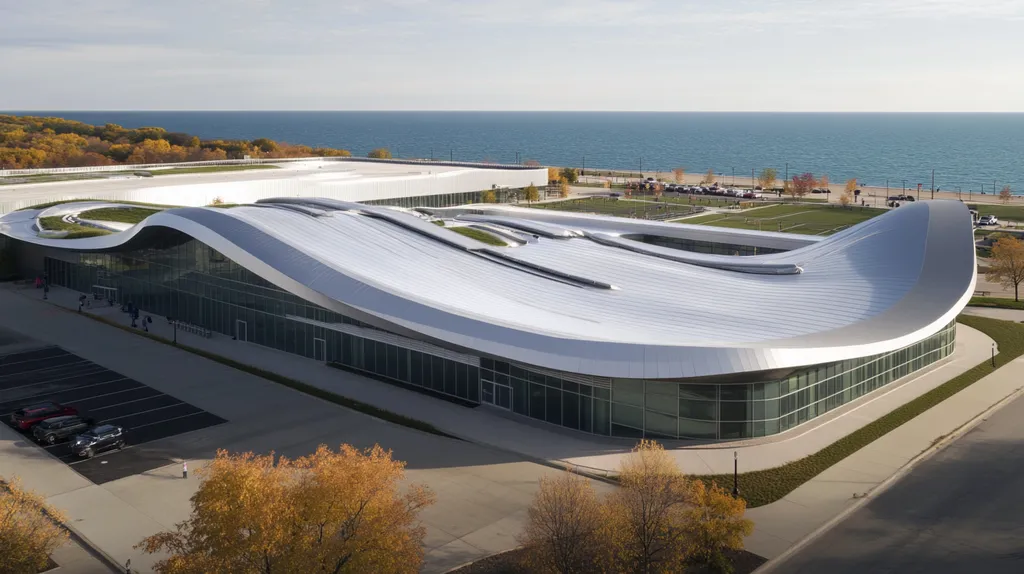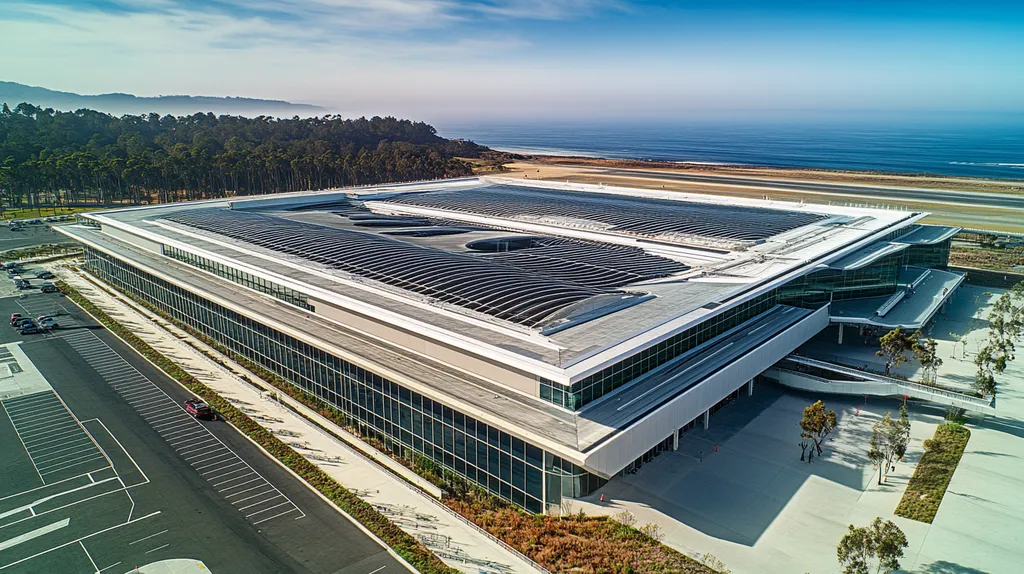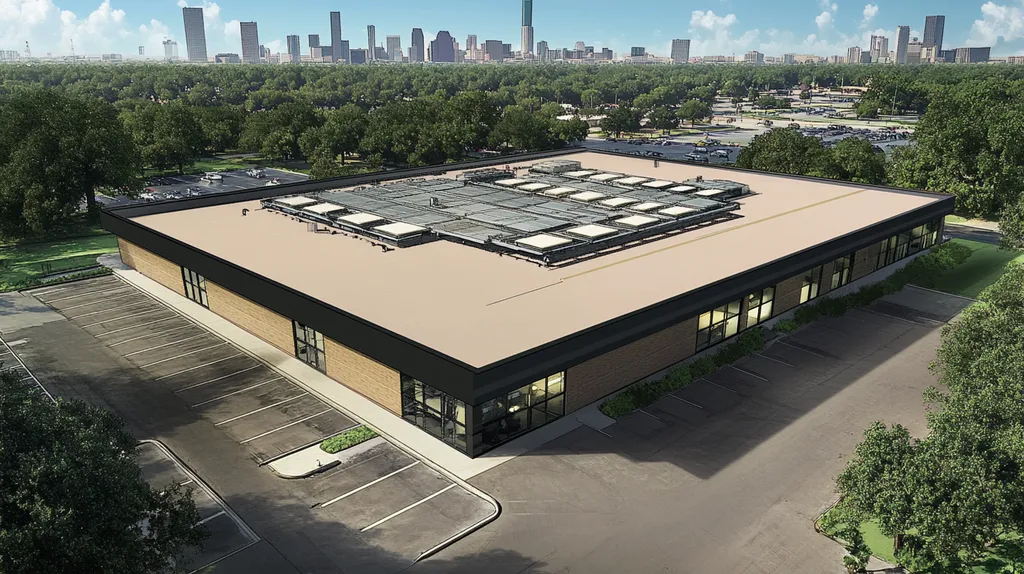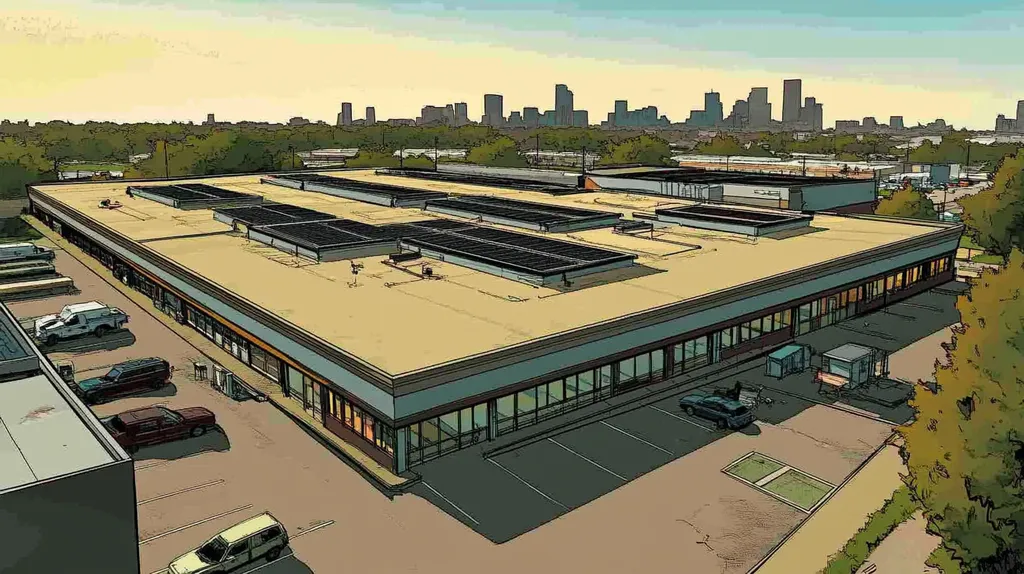Research shows that 40% of commercial roof failures stem from drainage issues caused by improper coating selection and application. These preventable problems cost facility managers millions in repairs annually.
Understanding how coatings affect drainage patterns is crucial for protecting valuable roofing assets and avoiding structural damage. Poor coating choices can block drains, create ponding water, and accelerate membrane deterioration.
This comprehensive guide examines coating selection criteria, application best practices, and maintenance protocols that optimize drainage performance while maximizing roof longevity.
SECTION 1: PERFORMANCE FACTORS
Understanding the vital interplay between roofing coatings and drainage systems is essential for facility managers. Failing to acknowledge this relationship can result in significant water damage and accelerated wear of roofing assets. By grasping how coatings influence drainage patterns, membrane integrity, and weather resistance, managers can safeguard both the building structure and operational efficiency.
Coating Impact on Drainage Patterns
The choice of roof coatings greatly affects drainage patterns on commercial roofs. Inconsistent application can create low spots where water collects, heightening the risk of leaks and ponding. This drainage complication can shorten the roof’s lifespan and increase ongoing maintenance costs.
If coatings are applied too unevenly or are excessively thick, they can disrupt the natural water flow. For instance, a roof’s slope may no longer function properly, leaving certain areas damp longer. This persistent moisture can encourage the growth of mold and algae, which further damages the roof.
Moreover, coatings can alter the effectiveness and placement of existing drainage systems. Assessing drainage adequacy before and after coating application is critical. Facility managers must ensure that drainage solutions are compatible with the roof’s updated surface characteristics.
Key Action Items
Effects on Roof Membrane Integrity
Coatings can significantly influence the integrity of the underlying roof membrane, which is crucial for durability. A well-chosen coating enhances membrane protection, while a poor selection can lead to premature wear. Ideally, coatings should shield membranes from harmful UV rays and extreme temperature fluctuations, thus prolonging their lifespan.
However, some coatings may chemically react with membrane materials. For example, solvent-based coatings can damage thermoplastic membranes, creating weak spots. This risk underscores the importance of selecting compatible roofing materials.
Additionally, while coatings add insulation, incorrect installation may trap moisture beneath them, increasing the risk of membrane degradation. Regular inspections and proper application techniques are essential to safeguard membrane integrity while reaping the benefits of roof coatings.
Key Action Items
Role of Coatings in Weather Resistance
Weather resistance is a key component of roofing performance, and coatings significantly contribute to this characteristic. A high-quality coating serves as a protective barrier against environmental challenges like rain, snow, and UV radiation, enabling roofs to withstand harsh conditions.
Properly selected coatings can also improve energy efficiency by reflecting heat, thus lowering cooling costs during warmer months. For instance, reflective coatings help maintain cooler rooftop temperatures, benefiting energy savings and enhancing indoor comfort.
However, not all coatings provide adequate protection against severe weather conditions, such as hail or intense winds. Facility managers must thoroughly assess coating specifications in relation to local climate to ensure maximum effectiveness. Additionally, ongoing maintenance is crucial; regular inspections will confirm the coating’s condition and facilitate timely repairs, preventing extensive damage and prolonging roof longevity.
Key Action Items
SECTION 2: FINANCIAL CONSIDERATIONS
Understanding the financial aspects of roof coatings is essential for the long-term viability of commercial and industrial properties. Ignoring the balance between costs and benefits can lead to unforeseen expenses that disrupt budgets. By investing in high-quality coatings, facility managers can avoid costly repairs and extend the life of the roof, underscoring the importance of strategic financial planning. This section examines the costs of coatings versus replacements, their influence on maintenance and lifespan, and effective budgeting strategies.
Cost of Coatings versus Replacement
Investing in roof coatings often proves to be significantly less expensive than a complete roof replacement. For instance, replacing a commercial roof can cost between $5 and $10 per square foot, while high-quality coatings typically range from $1 to $3 per square foot. This cost difference makes coatings an appealing option for extending roof life.
Facility managers should look beyond immediate costs to assess long-term savings from increased durability. Coatings can safeguard against harmful UV rays and leaks, reducing the likelihood of expensive repairs. Evidence suggests that well-maintained coatings can last for over a decade, while replacements may offer similar lifespans.
Furthermore, using coatings as a preventive approach can reduce the frequency of extensive repairs, allowing property owners to redirect funds to other vital areas, like energy efficiency upgrades. Ultimately, a thoughtful cost-benefit analysis is crucial for maximizing these financial advantages.
Key Action Items
Impact on Roof Lifespan and Maintenance
The inclusion of roof coatings can dramatically enhance the lifespan of commercial roofing systems. By providing a protective layer, coatings help shield roofs from environmental elements that lead to wear and tear. This advantage can lead to significant savings for facility managers as it delays the need for costly replacements.
Research indicates that a properly maintained coating can extend a roof’s lifespan by as much as 25%. Since roof replacements can disrupt business operations, minimizing these interruptions through effective maintenance becomes a key financial consideration.
Proactive inspections and maintenance of coatings help catch minor issues early, preventing more significant repair expenses. By choosing coatings that require only periodic reapplication, facility managers can avoid extensive repairs and the associated costs of total replacement.
Key Action Items
Budgeting for Coatings Application
Effective budgeting is vital for successfully implementing roof coatings. Facility managers need to consider the total cost of ownership, which includes application costs, materials, labor, and potential disruptions during installation. Allocating sufficient funds for both the initial application and future maintenance is essential.
A comprehensive budget plan that incorporates routine maintenance checks can enhance the performance and lifespan of coatings. Anticipating future expenses helps property owners avoid financial surprises associated with neglected roofs.
Additionally, facility managers should explore available governmental incentives or rebates for energy-efficient roofing solutions, as these can help offset initial costs. Engaging with contractors during the budgeting process will provide valuable insights into realistic cost forecasts and financing options.
Key Action Items
SECTION 3: COMPLIANCE REQUIREMENTS
Compliance with regulations regarding roof coatings is critical for property owners and facility managers. Ignoring these rules can result in substantial fines, increased liability, and risks to the building’s structural integrity. As recent legislation increasingly emphasizes sustainable practices, understanding these compliance requirements becomes all the more essential. This section will delve into important regulatory standards, the environmental effects of coatings, and the safety regulations that govern their application.
Regulatory Standards for Roof Coatings
Regulatory standards dictate the materials and methods used for roof coatings to prevent harm to public health and the environment. These standards ensure that coatings do not contain excessive volatile organic compounds (VOCs), which can harm air quality and health. Ignoring these regulations can result in bans on certain coatings or hefty penalties.
The Environmental Protection Agency (EPA) oversees regulations that may vary by region, and many states enforce local building codes alongside national mandates. Facility managers should familiarize themselves with both tiers of standards to ensure they meet durability, performance, and compliance requirements.
Certifications such as Energy Star can also guide product choices, enabling facility managers to select coatings that improve energy efficiency and meet environmental goals. Regular audits and updates on regulatory changes are essential in maintaining ongoing compliance.
Key Action Items
Environmental Impact of Coatings
The environmental effects of roof coatings are significant for facility managers to consider. Many coatings can emit harmful chemicals if not properly regulated, which underscores the importance of understanding their lifecycle impacts. Selecting coatings designed to minimize environmental damage is a wise choice for sustainable operations.
Today’s coatings often reflect UV rays, reducing energy consumption and heat absorption. This not only lowers energy costs but also helps create cooler urban environments, aligning with energy efficiency goals that may qualify properties for tax incentives.
Opting for low-VOC coatings exemplifies how compliance with environmental standards can enhance performance without compromising safety. Prioritizing the environmental implications of roof coatings not only boosts reputations but contributes to long-term asset value by fostering sustainable practices.
Key Action Items
Safety Regulations for Coating Application
Safety regulations are crucial during the application of roof coatings to protect workers and minimize risks associated with hazardous materials. Compliance with Occupational Safety and Health Administration (OSHA) standards is imperative for safe operations.
Facility managers must ensure employees applying coatings receive proper training and equipment. Safety data sheets (SDS) should be reviewed prior to application, helping to prevent accidents and avoid unhealthy exposure to chemicals.
Providing the necessary personal protective equipment (PPE) is also essential. Workers should have access to gloves, respirators, and eye protection to adhere to safety protocols. Regular safety audits can ensure high standards are consistently met, fostering a responsible safety culture within the organization.
Key Action Items
SECTION 4: RISK MANAGEMENT
Effectively managing risks linked to roof coatings is crucial for preventing costly damage and ensuring the roof system’s longevity. Coating failures can lead to serious water penetration, threatening the building’s structural integrity. Research indicates that nearly 20% of commercial roofs encounter issues with ponding water, resulting in increased maintenance expenses and a shortened lifespan for roofing materials. Therefore, recognizing these risks is vital for facility managers.
Assessing Coating Failure Risks
A comprehensive understanding of the risks associated with roof coatings is essential for effective management. Factors such as UV exposure, temperature fluctuations, and the quality of application can all lead to coating failure. Regular evaluations of these elements empower facility managers to address issues before they develop into major problems.
Advanced technologies like infrared thermography can be instrumental in pinpointing weaknesses in coating performance. Routine inspections should also assess the adhesion and flexibility of the coating as time goes on. By recognizing potential risks early on, proactive steps can be taken to enhance the roof’s durability.
Keeping detailed records of previous coating applications, including types of materials used and installation timelines, provides a valuable resource for future assessments. This data-driven strategy enables property owners to make informed decisions regarding maintenance and replacement, ultimately leading to better long-term cost management.
Key Action Items
Preventing Ponding Water Issues
Ponding water is a leading cause of roofing system failures. When water pools on a roof, it can create pressure points, leading to material fatigue and eventually to leaks. Facility managers must ensure that drainage systems are functioning well and that roofs are designed to facilitate water runoff effectively.
Routine inspection and maintenance of gutters, downspouts, and drains are essential to prevent debris buildup that causes ponding. Implementing a strict cleaning schedule can drastically decrease the likelihood of water accumulation. Additionally, incorporating sloped elements during roof installation can significantly improve drainage efficiency.
Immediate action is required if ponding occurs. Temporary solutions, such as using portable pumps, can manage the situation until long-term fixes are put in place. A solid understanding of proper drainage will empower facility managers to make informed decisions regarding their roofing systems.
Key Action Items
Mitigating Coating-Related Leaks
Coating-related leaks pose a serious risk to commercial roofs. When coatings fail, the underlying substrate can become vulnerable to moisture, leading to costly repairs. Facility managers should concentrate on monitoring potential leak sources, particularly around seams and penetration points.
Implementing quality control measures during the application process is crucial. Ensuring coatings are applied at the recommended thickness and the surface is adequately prepared can significantly reduce the likelihood of leaks. Moreover, selecting high-quality materials will enhance performance and lifespan.
Regular inspections for early signs of wear are also vital. Checks for discoloration, bubbling, or cracking can reveal issues that may lead to leaks if not promptly addressed. Developing a proactive maintenance routine can dramatically reduce leak occurrences and extend the longevity of the roof.
Key Action Items
SECTION 5: OPERATIONAL PROCEDURES
In the world of commercial roofing, selecting the right coating is crucial for optimal drainage performance. Failure to do so can lead to significant issues, potentially costing property owners dearly in repairs and maintenance. Understanding the relationship between coatings and drainage systems not only prevents water damage but also ensures long-term roof integrity. This section details essential operational procedures to enhance coating effectiveness while guaranteeing proper drainage.
Coating Selection and Application Process
The choice of roof coatings directly influences drainage performance. Facility managers should carefully select coatings that are compatible with existing materials and specifically designed to manage water flow effectively. For example, reflective coatings can significantly reduce the risk of thermal expansion and contraction, thereby alleviating stress on drainage systems.
Proper application techniques are vital. Ensuring an even coating layer prevents water pooling that can overwhelm drainage infrastructure. Engaging experienced contractors familiar with local climate conditions can enhance decision-making during the selection and application phases.
Additionally, preparing a smooth surface prevents water from accumulating in low areas. A well-applied coating promotes effective runoff, improving the overall functionality of drainage systems. Continuous staff training on updated application methods can yield further improvements in application quality.
Ensuring Proper Drainage Systems
Robust drainage systems are essential for the longevity of coated roofs. Property owners must evaluate the roof’s drainage capacity before coating installation. A blockage in drainage systems can lead to dangerous water accumulation and increased pressure on roofing materials.
Implementing effective drainage plans that account for elements like scuppers and gutters is critical. Larger roofs may require additional drains to manage water accumulation efficiently.
Regular assessments of drainage systems are crucial, especially following severe weather events. These inspections can catch blockages early, helping to prevent serious issues down the road. Additionally, upgrading drainage systems as part of routine maintenance can reflect well on the property’s management.
Maintenance and Inspection Protocols
Routine inspections and maintenance are vital for both coatings and drainage systems. Establishing a reliable schedule for regular checks—at least bi-annually—is crucial for optimal management.
During these inspections, facility managers need to look for signs of coating wear, such as cracking or peeling, which may lead to drainage complications if left untreated. Staff should also be trained to watch for drainage system functionality and blockage issues.
Effective communication within the team regarding any observed problems is key for ensuring timely repairs. Documenting all maintenance activities enhances accountability and aids in long-term strategic planning, benefiting both the roof’s longevity and the overall performance of the facility.
SECTION 5: OPERATIONAL PROCEDURES
In the commercial roofing sector, the correct selection of coatings is crucial to ensure optimal drainage performance. Research indicates that approximately 35% of roofing failures stem from inadequate drainage caused by improper coating choices. Facility managers must understand how coatings interact with drainage systems to prevent costly repairs and preserve roof integrity. This section provides vital operational procedures to enhance the effectiveness of roof coatings while ensuring efficient drainage systems.
Coating Selection and Application Process
The choice of roof coatings directly impacts drainage efficiency. Facility managers must prioritize coatings that are compatible with existing materials and engineered to facilitate proper water flow. For example, reflective coatings can minimize thermal expansion and contraction, thereby lessening stress on the drainage systems.
Application techniques also play a vital role; ensuring an even layer can prevent water pooling that might overwhelm drainage infrastructure. Engaging skilled contractors familiar with local climate conditions can enhance decision-making regarding both coating selection and application.
Moreover, preparing a smooth surface prior to coating application helps prevent water from pooling in low areas. A properly executed coat fosters effective runoff and boosts the drainage system’s overall functionality.
Continuous staff training on the latest application methods is essential for improving quality. Staying updated with industry standards is crucial to avoid overlooking factors that could impact drainage efficiency.
Key Action Items
Ensuring Proper Drainage Systems
Effective drainage systems are vital for extending the life of coated roofs. Before selecting coatings, property owners must evaluate the roof’s drainage capacity. A blocked drain can result in water backup and increased pressure on roofing materials, leading to premature failure.
Implementing comprehensive drainage plans that account for existing features like scuppers and gutters is essential for mitigating risks. For larger roofs, adding more drainage points may be necessary to handle potential water accumulation effectively.
Regular assessments of drainage systems are critical for identifying blockages early, especially after intense weather events. Proactive evaluation and updates to drainage systems as part of routine maintenance can lead to improved performance and demonstrate proactive management to stakeholders.
Key Action Items
Maintenance and Inspection Protocols
Routine maintenance and inspections are essential for the longevity of coatings and drainage systems. Establishing a reliable schedule for regular checks—at least bi-annually—is crucial for effective management.
During inspections, facility managers should actively look for signs of wear on coatings, such as cracking or peeling, which can lead to drainage complications if left unaddressed.
Staff must also be trained to monitor drainage systems for blockages and operational efficiency. Effective communication regarding observed issues facilitates prompt repairs, preserving both the coating and the underlying structure.
Documenting all maintenance activities enhances accountability and aids in strategic long-term planning. This systematic approach prolongs roof life and improves overall facility performance.
Key Action Items
The Bottom Line
Research shows that 40% of commercial roof failures stem from drainage issues caused by improper coating selection and application, costing the industry over $3.4 billion annually in preventable repairs.
Facility managers who implement comprehensive coating and drainage maintenance programs report a 75% reduction in emergency repairs and a 25% increase in roof lifespan.
The interplay between coatings and drainage systems demands ongoing vigilance through regular inspections, proper application techniques, and swift remediation of issues.
As regulations tighten and weather patterns become more extreme, the strategic management of roof coatings and drainage will become increasingly critical for protecting commercial building assets.
Success requires a proactive approach that balances coating selection, application methods, maintenance protocols, and regulatory compliance to ensure optimal drainage performance.
FREQUENTLY ASKED QUESTIONS
Q. How do commercial roof coatings affect drainage systems?
A. Roof coatings can significantly impact drainage by creating low spots and altering water flow patterns. Ineffective application leads to water accumulation, resulting in leaks and increased maintenance costs. Regular inspection of drainage areas post-application is essential.
Q. What are the costs of coatings compared to commercial roof replacements?
A. Coatings are often far cheaper, costing between $1 to $3 per square foot versus $5 to $10 for replacements. Investing in coatings can extend roof life and reduce ongoing repair expenses, making it a cost-effective solution for facility managers.
Q. What compliance requirements apply to commercial roof coatings?
A. Compliance requires adherence to local and national regulations, particularly regarding VOC emissions. Facility managers should ensure that selected coatings meet these standards to avoid penalties and align with sustainable practices for environmental benefits.
Q. How can facility managers manage risks with roof coatings?
A. Managers can mitigate risks by regularly assessing coating performance, identifying potential failure points like UV exposure and application quality. Implementing proactive maintenance and keeping thorough documentation will aid in managing repair costs effectively over time.
Q. What operational procedures enhance coatings for drainage?
A. Selecting compatible coatings, ensuring proper application techniques, and maintaining smooth surfaces are vital for optimal drainage. Regular training for staff on application methods will also enhance coating effectiveness and minimize potential drainage complications.
Q. How can I ensure effective maintenance of coatings on roofs?
A. Schedule bi-annual inspections to monitor coatings for wear and drainage effectiveness. Regular cleaning and upkeep of drainage systems are essential, as is documenting all maintenance activities to facilitate strategic planning for future needs.
Q. How to choose the right coating for my industrial roof?
A. When selecting a coating, consider the roof’s material compatibility, local climate conditions, and intended performance, including UV resistance and thermal properties. Engaging with experienced contractors can also provide insights into optimal products for your specific requirements.











